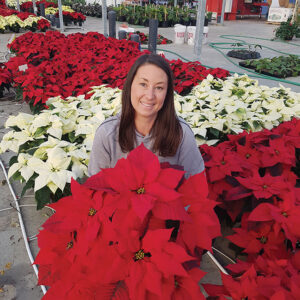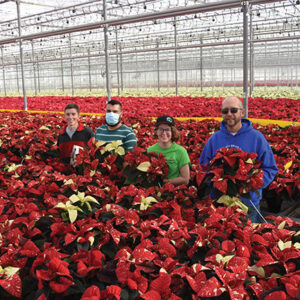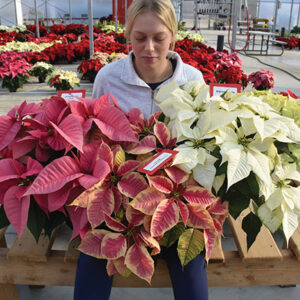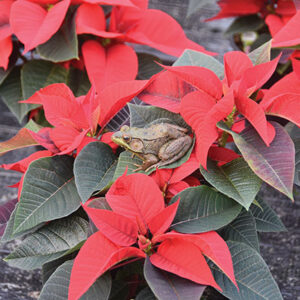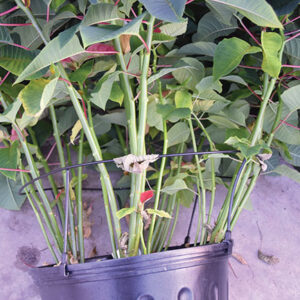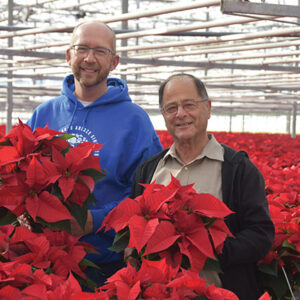
Features
The 2022 poinsettia season
Despite challenges, season ended with strong demand.
April 27, 2023 By Melhem Sawaya
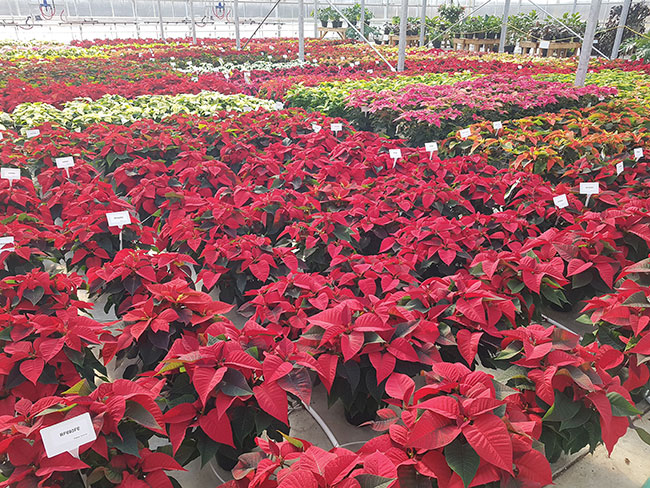 Pots of 152 varieties were trialled.
Pots of 152 varieties were trialled. Poinsettia season 2022 in a summary would have been a successful season if it was not for:
- White flies on a very limited but popular variety shipped with the cuttings but nothing compared to 2021 poinsettia season
- Shipping costs still going up.
- Boxes prices doubled if you did not order and received them before poinsettia shipping season.
- Stores did not want to give enough display area for poinsettias, which lead to frequent smaller orders.
Despite these few but costly hiccups the season ended up with strong demand for this year’s poinsettia crop which was helped by mild weather or at least no snowstorms to stop shipping or shopping, yes poinsettia season is as dependent on the weather as much as the bedding plant season is.
Was any profit in this year’s poinsettia crop?
It would have been a good year except the cost of producing the crop kept increasing due to many factors that normally you know about early in the season, like shipping costs, heat, packaging and imported white flies.
With all the increased costs poinsettia prices next year must be increased by at least 15 to 20 per cent. On the positive side, all that was grown was sold, with a two- to three-per-cent shortage, which that where the market should end.
Stores reduced pre-booked orders to realistic numbers, learning from Spring 2022. You cannot increase 10-per-cent growth and another 10 per cent, which was a situational increase due to COVID-19. That led to a 20-per-cent shrinkage to many spring bedding plant producers.
No diseases through the whole crop, even without any fungicide applications.
No bract edge burn, which we haven’t seen for the past 10 years, which coincides with the adoption of biocontrol to control pests; mainly white fly. This is a success story where we solved the problems by eliminating the cause and didn’t concentrate on the treatment, which is more economical and had greener growing by avoiding the overuse of chemicals.
Bract edge burn was due to the use of Thiodan for the control of white flies in addition to high humidity in the greenhouses, and the Accademia and chemical companies fast remedy most of the time for how to treat the problem rather than how to prevent it. Tons of calcium chloride was the go-to cure where, in my opinion, it was only a band-aid and the results were barely satisfactory. I am writing all of this to stress the need to always find the cause of any problem along with dealing with how to remedy it in the meantime.
Production
It was the optimum weather conditions for flower initiation, cool nights and higher than average light levels. Every greenhouse crop was ready, on average, a week earlier than other years. In addition to the optimum weather conditions for flower initiation, the new varieties are bred to flower much earlier. In our trials this year, 96 per cent of the varieties were ready for sale by November 1.
Micro drenches of Bonzi can be used at any stage of production and it will not decrease the bracts to be unsalable. Proper application of Bonzi will produce a much better-quality product. Like every treatment, if done properly, it is an enhancement to the finished product.
The use of Bonzi micro drenches is a standard procedure, so using it properly is important. This year I have seen some plants treated with Bonzi with not much of an effect, while with other operations the effect of Bonzi is too much.
Here some guidelines to consider when you are using Bonzi:
- Application should be uniform especially if you are using drip system. Use lower rates with high volume so the whole root ball is covered. This is also important in normal irrigations with drip systems.
- Treatments when the plants are in the fast-growing stage are more effective. This goes with using any growth regulator.
- Avoid any Bonzi applications over head, but if that is the only way you can apply it, then rinse with clear water using your sprayer, not the watering nozzles.
- Timing is the best growth regulator. You cannot delay planting too much to have shorter plants because the bracts will not colour properly in low light conditions.
- If later crop sale date is required, use a later flowering variety in its own section where you can control the temperature to suit without affecting other cultivars. Some crops that were shipped later in the season but not programed for that showed signs of botrytis on the bracts, flowers or both.
Other factors to watch for
- If you are spraying cycocel be aware of your clear water EC. because high water ECs added to the cycocel EC could be phytotoxic and will cause leaves damage.
- Still the best Botrytis control is lower humidity.
- Best crops happen when all aspects of production are done on time.
- Yes, I am saying it again and it will not be the last time: growing crops is 15% knowledge, 15% knowing how to apply this knowledge, and 70% doing everything on time.
- Doing things on time is a major part of growing green, because then fewer or no chemical treatments needed.
Trials
This is the second year the poinsettia trials took place at our brand-new greenhouse and location at Sawaya Gardens.
Over 150 varieties all propagated by Linwell Gardens planted in 6” pots on week 31, pinched week 34. Twenty-four pots of each variety, all watered the same, no growth regulator was used. This way, the true growth habit of every variety was clearly evident. Here my observations.
- All varieties could be commercially acceptable to ship.
- Varieties first shippable dates were recorded, which varied from October 15 to November 25, but most of them were still shippable past December 15.
- Not long ago, we had a maximum of 20 varieties to choose from. We had in our trials over 150 varieties and that is not all of them. The choices are vast, which makes the trials more crucial so we can decide on the cultivars that suit our production practices, and more importantly, our customers needs.
- Only if we try some of these varieties in our production and present it to our customers, we can capitalize on different packaging with unique colours and habits that the breeders came up with that can change look at poinsettia as just red, white and pink. In bedding plants, mixed containers are so popular that have almost 50% of the large container market. Why not in poinsettia?
- In my opinion 85 per cent of the poinsettia sold are red because we are not introducing the new cultivars like we do with bedding plants.
- After we were done with the trials, we open the greenhouse to the public for two days. The customer comes looking for red poinsettia and goes out with four colours and one red, and that was the case for the majority. This was because there were so many colours in the trials they could not leave without selecting two or three other colours or shapes. Poinsettia sales could net another 10-per-cent increase if we market it like bedding plants. Well displayed and taking advantage of all these new varieties.
- No chemicals were sprayed to control whiteflies. Some of the varieties had whitefly eggs and larva on them, but the team at Bioworks took charge of the whitefly control. By the time of the open house, I could not see any whiteflies.
- The bracts on most varieties were larger than normal most probably because:
- No growth regulators were used.
- Temperature heating to 19 degrees and venting at 22.
- Full sun from sunrise to sunset independent of what the temperature is.
- No delay in bud set and full sun, which increases the average temperature and maximum light intensity
is a recipe for large bracts.
Problems
Diseases
All growers experienced no issues with any kind of diseases except for few Erwinea incidents that were directly related to the plant stressed before sticking.
No issues with root problems and no preventative fungicides were applied. Diseases do not want anything to do with happy plants, and happy plants do not welcome diseases.
Proper watering, checking ECs and pHs with proper environment conditions set the plants to be healthy and no need for fungicides.
Insects
The biocontrol was sufficient to carry the crop all the way to the market without any whitefly concerns except for a very few situations.
Advice for next year is to check the cuttings thoroughly upon arrival and to be discarded if whiteflies are detected. No biocontrol or chemical is going to clean heavily infested cuttings.
In our trials, the bioprogram was carried out by plant products and I’m excited to say that the crop could have been shipped without any whitefly without any chemical ever used. Judy Colly (plant products) gave a presentation at the open house that explained how it was done and what lessons were learned, covering:
- Importance of scouting where Beth Bylsma (Plant Products) done an excellent job with Judy.
- The different varieties attraction or resistant to whitefly.
- The effect of growth regulators on the efficacy of bios.
Reach out to Judy at Plant Products!
Before propagation and planting, the planting areas are to be cleaned thoroughly. And no pest plants or other crops around.
- Open the boxes in a cool room, dip in Botanigard solution and put in a cool room at 10 degrees overnight or at least four hours before sticking, making sure the cuttings are never dehydrated.
- Before planting, dip the cuttings in a mixture of
horticultural soap. - Start bio treatment soon after sticking the cuttings until October 10 to 15.
- Bios will carry the crop free of, or with negligible amount of whiteflies, unless overwhelmed with leaves loaded with eggs before they have a chance to do their job.
- Scouting and proper bios management is the only tool to combat the whitefly.
Summary
- Grow varieties that you are familiar with and try new ones on a small scale.
- Calculate your cost for any required specs and do not forget about packaging and shipping.
- Take an order when there is still margin profit and not just dollar sales.
- Never grow on pure speculation.
- When you’re running out of plants at the end of the season and you need to buy some, that is when you are starting to make headways profit-wise.
- Do not cheat on what the crop needs to grow properly, namely space and heat. It will cost you much more at the end.
- Start a study group with the growers in your vicinity, and if you are around southwestern Ontario, join us by sending me an email to include you and hopefully this year, we can make this happen.
Any suggestions that you like to see at the poinsettia trials next year are welcome. Next open house date is November 15.
Print this page
